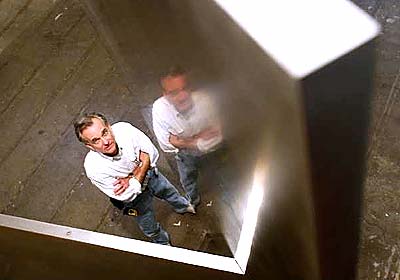|
November 14, 2002
ART
Onward means going upward
By Christopher Reynolds, Times Staff Writer
Edward Tufte lives in Connecticut, but among numbers nerds and graphics gurus, he's better known as a warrior-preacher who travels among dimensions, crusading for clearer thinking and better data.
Tufte, a wiry, vigorous man with silver hair, a pair of pens in his white shirt pocket and a tape measure on the hip of his jeans, was here to help install "Escaping Flatland: Sculptures and Prints," an exhibition that opened Nov. 7 at the A+D Architecture + Design Museum. The walls feature 22 oversized pages from his illustrated books and examples of his favorite graphics, from a 9th century Latin manuscript page describing and depicting the constellation Centaur to a scientific illustration of a pink-finned fish from 18th century Germany to a French skiing manual from 1947. The most striking part of the show, however, is not the two-dimensional stuff, it's the stainless steel in the middle of the high-ceilinged room. After four decades of fastidious labor in the field of fact, the writer, statistician and designer has taken up large-scale, 3-D, abstract sculpture. The two stainless-steel works that dominate the modest museum exhibition space (and will remain there until Feb. 13) are each about 12 feet high and 3,800 pounds. They are among 10 large-scale pieces he has completed so far. Each is arranged in a series of planes, so that they bounce light and soak up color from whatever surrounds them. "I'm trying to do color and beauty, not irony or tortured metal," Tufte said. "It's meant to be an intense, luscious experience." Tufte, who shares 20 acres in Cheshire, Conn., with his wife, graphic design professor Inge Druckrey, and three golden retrievers, is a 1960 graduate of Beverly Hills High School. His late father was head of public works for that city, and his mother, a professor of English at USC for three decades, still lives in Beverly Hills. This is Tufte's first exhibition in California, and only the second time he has exhibited his sculpture. But he is no stranger to iffy new enterprises. Tufte, who taught at Princeton from 1967 to 1977 and Yale from 1977 to 1999, entered publishing in 1982, when an Ivy League university press agreed to publish his first book, then told him that someone else would design it and that the book would sell for more than $64. Tufte had other ideas. He wanted control of the design, and a lower price. Tufte enlisted the help of a seasoned book designer and self-published "The Visual Display of Quantitative Information" -- and priced it at $32. A second mortgage on his house paid for the venture, even though the best interest rate he could get was 18.7% -- a particular horror for a trained statistician, but the strongest possible incentive to market fiercely. It worked. "I knew within about six months that we had saved the house," Tufte recalled. The Graphics Press (a.k.a. Tufte's garage and a nearby warehouse, on the Web at In those books, Tufte lionizes Galileo and Leonardo da Vinci as perhaps the greatest analytical designers in Western civilization; shows how a shrewd chart helped John Gotti's lawyers sway jurors by showing the pattern of past felonies among witnesses testifying against him; and posits that better graphics might have helped NASA staffers, who were alarmed by technical glitches but couldn't get their bosses' attention in their futile 11th-hour efforts to cancel the disastrous Challenger shuttle launch. His specialty has been viewed as an ephemeral and secondary mode of communication but Tufte, as reviewers of his books have written, brings to it a scholar's rigor and broad view of historical precedent. "Flatland" is Tufte's term for the two-dimensional page and computer monitor. "Escaping this flatland," he has written, "is the essential task of envisioning information, for all the interesting worlds (physical, biological, imaginary, human) that we seek to understand are inevitably and happily multivariate in nature." Elizabeth Martin, director of the fledgling A+D Museum and curator of the exhibition, calls Tufte's work "a friendly compass in an informational wilderness -- and, when necessary, a machete to chop through thickets of disinformation." After two decades of experimentation with small sculptures, Tufte said last week, he turned to these larger works four years ago, relying on the Tallix Foundry in upstate Beacon, N.Y., to follow his specifications. Stainless steel, he said, "is such a wonderful material. It's forever. It's indifferent to the weather, it doesn't oxidize." Like his graphics work, Tufte said, his art is about how a surface is imbued with information -- in this case, light dancing on steel, instead of ink fixed on paper. But as the artist is quick to say, the sculpture only stands up to so much conversation. "I think a lot of art chat is really reconstruction after the fact, trying to bring words to something that is inherently not a very verbal experience," said Tufte. And what about Tufte's colleagues in number-crunching circles? What do they think of all this? "I don't know," said Tufte merrily, "and I don't care." 'Escaping Flatland: Sculptures and Prints' Where: A+D Architecture + Design Museum, portico space, Bradbury Building, 304 S. Broadway, L.A. When: Monday through Saturday, 10 a.m. to 5 p.m. Ends: Feb. 13 Price: Free Parking: Bradbury parking structure, enter from Spring Street between 3rd and 4th. Cost is usually $6. Info: (213) 620-9961 Original article [external link]
|
||||
